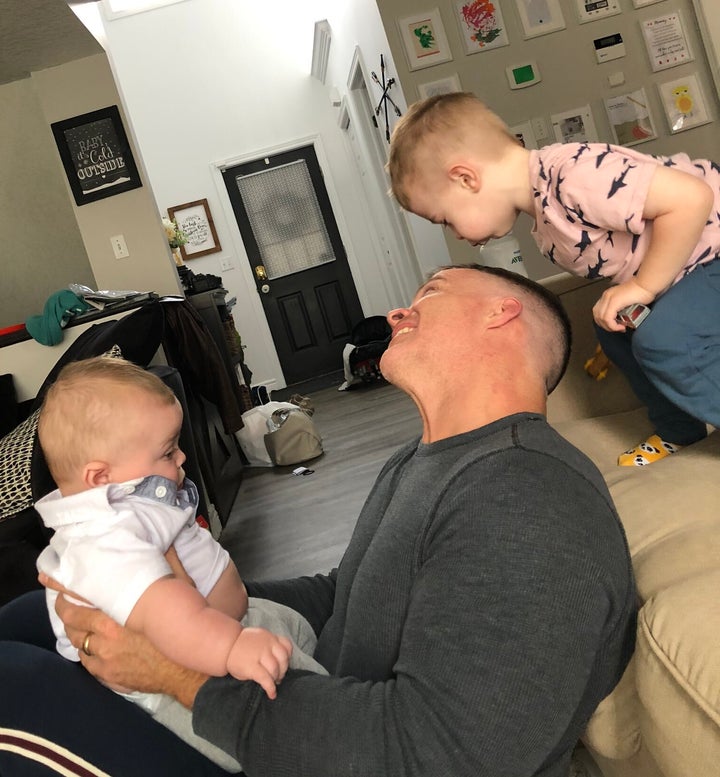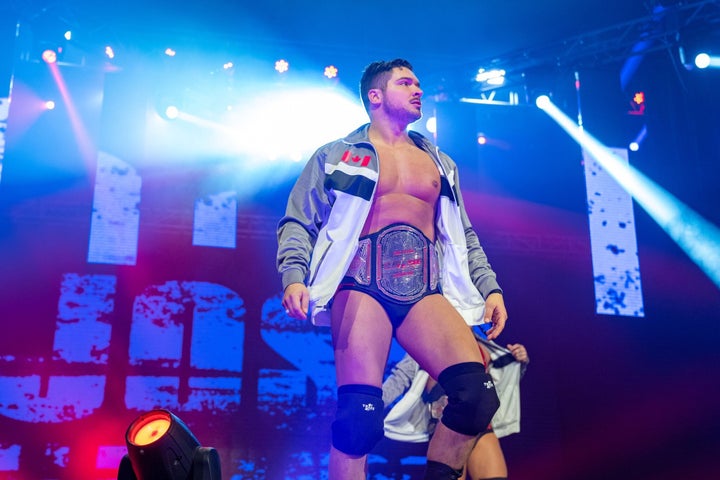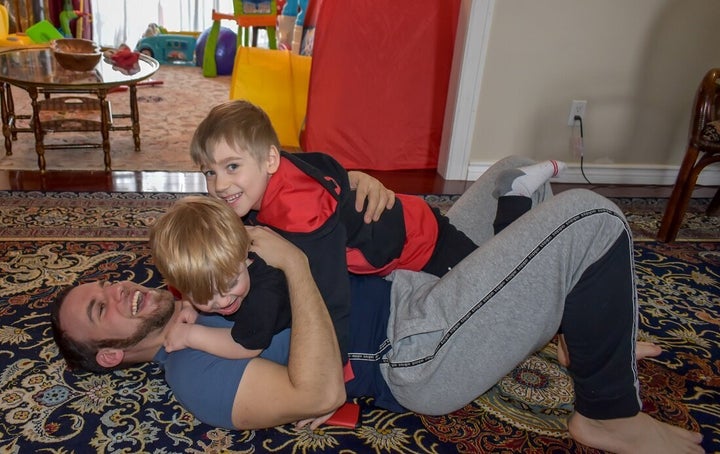Some kids are obsessed with slime and Baby Shark. Others just want to suplex their baby brother. Roughhousing has a special place in the hearts of Canadians who grew up getting swung around by their parents or giving their siblings noogies.
Dads especially are known to enjoy a good tussle. WWE lovers have gone viral practicing amateur wrestling moves on their little ones, with one even turning his matches into an ongoing series.
These antics may make for good YouTube content, but take it from a real wrestler like Tyson Dux. The London, Ont. professional wrestler, school founder, and father of four boys says roughhousing looks a lot different when an adult knows what they’re doing versus a parent who’s just going with the flow.
“A wrestler’s body control is like nobody else’s ... [these Youtube videos], they’re cute and amusing, but you run the risk of damaging your kid,” the 41-year-old explained. “Even when my son is jumping on me, I’m always protecting him.”
HuffPost Canada asked Canadian wrestler dads, both professional and amateur, about their views on play-fighting. It’s a given that entertaining audiences with show-stopping moves is in their wheelhouse. What’s less well-known is their fastidious philosophy around safety, factoring it into everything they do in the ring against opponents ― or at home with their kids.
What is roughhousing?
Dux grew up on Hulk Hogan and comic books. He decided to pursue professional wrestling because the suspension of disbelief was like magic to him.
“I love that it’s competitive, but it’s still a show,” Dux said. “If you watch someone like me perform, you’re taken aback. You don’t know if it’s real or not.”

When kids roughhouse, or rough-and-tumble play (RTP) as researchers call it, it’s a far cry from real fighting. Although parents may be divided on the merits of getting rowdy, research points to great benefits. Studies have shown that although boys usually favour rough-and-tumble play more, kids of all genders are interested. And as Fatherly notes, kids of all genders can reap the rewards.
Nikki Martyn, head of University of Guelph-Humber’s early childhood studies program, says horseplay is great for a child’s development and stimulates the brain’s capacity to remember and learn.
“When we engage in RTP, it builds emotional intelligence,” she adds. “We have to anticipate the next move, learn to regulate our emotions, or pull back.”
Safety first
Every dad HuffPost Canada talked to emphasized that a kid’s developing body makes them susceptible to getting hurt if they’re not careful.
That starts with where they wrestle. Ethan Page, a professional wrestler from Hamilton, Ont., says that roughhousing needs to be done the right way or not at all. When his daughter wants to throwdown, he’ll make sure there are plenty of pillows to catch her.
“We’re always having a laugh but I try to keep it as controlled as possible,” he told HuffPost Canada.
The 30-year-old guesses that he’s more gentle with his daughter Gabriella than most parents would be; even if she’s falling for a short distance, she’s still hitting the bed repeatedly.

Setting ground rules is another important step. Sheldon Francis, 36, is an Ontario high school amateur wrestling coach and a certified referee. As someone who’s taught both kids and his two sons how to wrestle on the mat, he says that structure keeps a match from devolving into hair-pulling chaos.
“A lot of it is making sure you’re empathetic towards your partner,” he said. “Realizing that if you don’t want to hurt them, you shouldn’t do this [move.]”
And before any punches or kicks are thrown, taking a fall the right way should be the first lesson: for wrestlers (and people of any age), taking a fall and rolling correctly is a valuable instinct to hone. When Dux gets knocked to the ground, he follows the same protocol he’s taught his sons.
“My first reaction is to tuck my chin and land as flat on my back as possible so I’m not reaching backwards,” Dux advised.
As with anything, making sure you have your kid’s permission is important. Martyn says that RTP is where a kid learns both what to do when they cross someone else’s boundary and what they should do when a boundary is crossed.
“As with everything, no means no,” Martyn said. “That’s how they gain control over their life and their own autonomy.”
“Sell” a good show
Page employs the art of “selling” in the ring to put on a good show. Putting on theatrics can make a punch with no weight look like it can level a building.
“When someone hits you, your reaction to it is as if it’s real,” Page explained. “With my daughter, I do the same thing.”
Selling works best when performers know what they’re doing beforehand. In professional wrestling, moves are often choreographed in order to minimize injury and wow viewers. With subtle body cues, they might telegraph to each other or the referee their intentions to initiative a move.
A trained wrestler knows exactly what to do to make a strike shine, but neither you or your kids need to enroll in acting classes anytime soon. After trying one move for the first time, a parent can give pointers on doing it right. Every time that move comes up in play, a kid can intuit how they should be moving their body.
Switch roles to teach fairness
Roleplay is a major part of both professional wrestling and roughhousing. Babyfaces and heels are wrestling roles used to differentiate between heroes and villains. Kids love pretending to be superheroes or other duelling champions, which Martyn says teaches kids how to be creative and how to play fairly.
But it’s no fun when one side wins all the time. As researchers have documented, RTP doesn’t involve aggression and rarely devolves into actual brawls. Kids who roughhouse right are happy to play different roles, even lose from time to time: if Dwayne “The Rock” Johnson could heel turn in his wrestling career, so can your family.
What to do when a kid gets rambunctious
It’s natural when energies are high for things to veer towards dangerous territory. Before a kid hurts themselves or others, Francis advises explaining the consequences of their movements before punishing them.
“When they’re really excited, tell them, ‘If you keep hurting your partners, nobody’s going to want to play with you,‘” he said. “And if you’re not going to listen, you’re not going to do the activity.’ They’re learning you can’t be super mean to somebody just because they want to be mean.’”
It might take more than one warning, Francis said, as especially young kids are prone to forgetting instructions when they’re having fun.
Francis hopes that parents are realistic: even if all safety measures are taken, risk can’t be completely eliminated. Should a kid gets hurt, Francis has told parents not to freak out: even a small accident can be a teaching moment.
“If they accidentally hurt someone, they’re very sad because they’ve done it to that person. Whereas if they’re playing a video game, obviously they don’t care [if they hurt another player,]” he said.
Don’t want to wrestle? That’s OK
Not all wrestler dads want their kids to follow in their footsteps. Sebastian Suave is a Toronto and London, Ont.-based professional wrestler, promoter, and founder of Smash Wrestling.
The father of a five-year-old and a two-year-old says he’ll swing his kids around, but won’t mimic wrestle with them.
“I have no problems if my sons get into wrestling, but I want it to be of their own accord,” Suave said. “I know how physically and mentally taxing it is. When one of them jumps on me, I’ll go ‘Easy, buddy.’”

Instead, Suave’s directed their energy into other outlets. He’s put his oldest in a circus gymnastics camp and his family often plays outdoors in sunny weather. Father-son bonding sessions are often done over video games like “Super Mario Odyssey;” his son is happy to pass the controller to dad when a boss comes onscreen.
Feel uncomfortable with play-fighting or letting them wrestle with other kids? Martial arts can help kids expend energy and get enough exercise. And amateur and professional wrestling lessons are a call away.
Also on HuffPost: